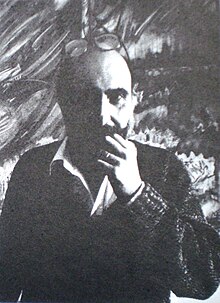Luis Felipe Noé
| Luis Felipe Noé | |
|---|---|

Luis Felipe Noé in 1980
|
|
| Born |
May 26, 1933 Buenos Aires, Argentina |
| Known for | Artist and Writer |
| Movement | Neofiguration |
Luis Felipe Noé (born May 26, 1933) is an Argentine artist, writer, intellectual and teacher. He is known in his home country as Yuyo. In 1961 he formed Otra Figuración (another figuration) with three other Argentine artists. Their eponymous exhibition and subsequent work greatly influenced the Neofiguration (Neo-figuration, New figuration) movement. After the group disbanded, Noé relocated to New York City where he painted and showed assemblages that stretched the boundaries of the canvas.
In 1965 he published his groundbreaking theoretical work, Antiestética. He then took a ten-year hiatus from painting and upon return to Buenos Aires opened a bar, taught, wrote and created installations with mirrors. A military coup coincided with his painting comeback, and in 1976 Noé migrated to Paris where he continued to experiment, both with canvas re-texturing and the drawing process. His later paintings move away from the figure and focus on elements of landscape.
Noé currently lives and works in Buenos Aires. His son, Gaspar Noé is a Franco-Argentine filmmaker.
Luis Felipe Noé studied painting with Horacio Butler from 1950 to 1952 but is “essentially considered self-taught.” He also studied law at the Universidad de Buenos Aires and wrote art reviews for various newspapers prior to his first exhibit in 1959 at the Galeria Witcomb.
In 1960 the artists of Otra Figuración began to live and work together in an apartment building that doubled as a studio in Carlos Pellegrini Street in Buenos Aires. The collective included Rómulo Macció, Ernesto Deira, Jorge de la Vega, Luis Felipe Noé and for a short while, Antonio Seguí who exhibited briefly with the group but is not generally considered a member of Otra Figuración since his style quickly diverged. The “violent, disturbing” work that emerged from the group’s first exhibition at the Galeria Peuser in 1961, also titled Otra Figuración “reflected a nation whose history and everyday life were so marked by violent occurrences.”
His two seminal paintings from this period are Introduccion a la esperanza (Introduction to Hope) and Cerrado por brujería (Closed for Sorcery), both from 1963. Esperanza won the prestigious Premio Palanza given by the Instituto Torcuato Di Tella in 1963. The painting depicts an amorphous, riotous mass of open-mouthed figures proferring signs that read “Champion, do not leave us,” and “Vote for blind force,” while additional signs set on plywood stems sprout from the top of the canvas and display portraits of political candidates. The work embodies nine separate canvases, communicating a sense of the overwhelming anarchy and continual unrest that defines Argentina’s political process. The crowd forms one massive animal that blindly jostles and lobbies for some low level of survival, complicit in elevating the oppressors who cynically grin and bob far above them. In contrast, Cerrado depicts the people not as an indistinguishable mass but as individual grimacing visages trapped within a grid of boxes. The cloaked figure of a sorcerer looms above, nullified by a crucifix, surrounded by ferocious, fantasy animals. The iconography and structure of the painting suggest ideological incoherency and social chaos, belief systems or regimes continually supplanting one another and in flux while the citizens remain caged.
...
Wikipedia
